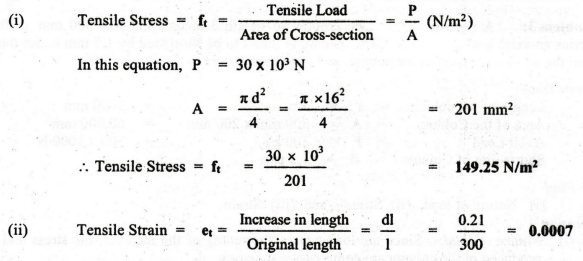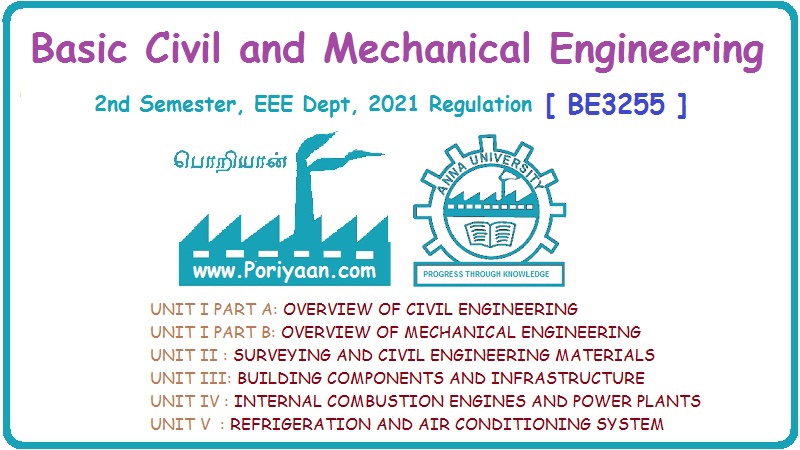Basic Civil & Mechanical Engineering: UNIT I: b. Structural engineering
Illustrative examples - I
Solved Problems - Stress and strain | Structural engineering
Basic Civil & Mechanical Engineering : UNIT I : Structural engineering : ILLUSTRATIVE EXAMPLES - I
ILLUSTRATIVE EXAMPLES - I
Problem
1:
A steel rod of 16 mm diameter and 300 mm long is subjected to a tensile load of
30 kN. Determine the intensity of stress and strain if the elongation of the
rod due to the load is 0.21 mm.
Given
Data
Diameter
of the rod = d = 16 mm
Length
of the rod = 1 = 300 mm
Tensile
Load = p = 30 kN = 30 × 103 N
Elongation
of the rod = dl = 0.21 mm
To
Find
(i)
Tensile Stress and (ii) Tensile Strain
Solution

Problem
2:
A steel wire of length 10 m and diameter 5 mm is used to hang a load at its
bottom. The stress and strain in the wire are found to be 140 N/mm2 and 0.0007
respectively. Determine the load it carries and the elongation of wire.
Given
Data
Diameter
of the wire = d = 5 mm
Length
of the wire = l = 10m = 10,000 mm
Tensile
Stress = f1 = 140 N/mm2 (Since the load is hung by the wire.)
Tensile
Strain = 0.0007
To
Find
(i)
Tensile Load P and (ii) Elongation of the wire dl
Solution

Problem
3:
A rectangular wooden column of length 3 meters and size 300 mm x 200 mm carries
an axial load of 300 kN. The column is found to be shortened by 1.5 mm under
the load. Find the stress and strain in the column and state their nature. (AU)
Given
Data
Length
of the column = 1 = 3 m 3000 mm
Area
of the Column = A = 300 mm × 200 mm = 60,000 mm2
Axial
Load P = 300 kN = 300 × 1000 N
Shortening
of Column = dl = 1.5 mm
To
Find
(i)
Nature of load, (ii) Stress and (iii) Strain
Solution
(i)
Nature of load: Since the load causes shortening of the member, the stress and
strain produced in the column are compressive in nature.
(ii)
Compressive Stress = fc = Compressive Load / Area of Cross-section = P / A
300
× 1000 / 60,000 N/mm2 = 5 N/mm2
(iii)
Compressive Strain = ec = Decrease in length / Original length = dl / l
=
1.5 / 3000 = 0.0005
Problem
4:
An axial tensile load of 10 kN is applied on a steel rod. Find the diameter of
the rod if the stress is not to exceed 10 MN/m2.
Answer:
Diameter of the rod = d = 35.68 mm [1 Mega Newton = 106 N]
Problem
5:
Three rivets of diameter 30 mm are provided to carry a total shear force of 210
kN. Determine the stress developed in the rivets.
Given
Data
Shear
carried by 3 rivets = 210 KN
Shear
carried by 1 rivet (P) = (210/3) = 70 kN = 70 × 103 N
Diameter
of rivet (d) = 30 mm
Solution
Area
of cross-section of one rivet = A = π × 302 / 4 = 706.9 mm2
Shear
Stress = q = P / A = 70 × 303 / 706.9 = 99.02 N/mm2
Problem
6:
Find the force required to punch a 16 mm diameter hole in a plate of 20 mm
thickness, if the shear strength of the material of the plate is 340 MN/m2.
(AU)
Solution

Problem
7:
A truss member is connected to a tie bar by means of four bolts. The allowable
shear stress in the bolts is 110 N/mm2. Compute the minimum diameter
of bolts, if the maximum load in the bar is 100 kN.
Solution
Shear
Stress = q = P / A = 110 N/mm2
Total
Area of cross-section of 4 bolts = A = P / q
=
100 × 103 = / 110 = 909.09 mm2
Area
of cross-section of 1 bolt = (909.09 / 4) = 227.27 mm2
Diameter
of bolt = d = 17.3 mm
Hence,
adopt 18 mm diameter bolts.
Basic Civil & Mechanical Engineering: UNIT I: b. Structural engineering : Tag: : Solved Problems - Stress and strain | Structural engineering - Illustrative examples - I
Related Topics
Related Subjects
Basic Civil and Mechanical Engineering
BE3255 2nd Semester 2021 Regulation | 2nd Semester EEE Dept 2021 Regulation
